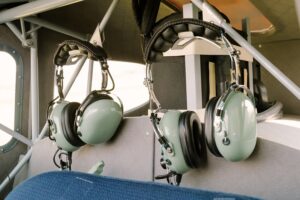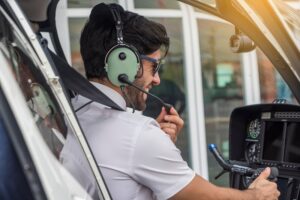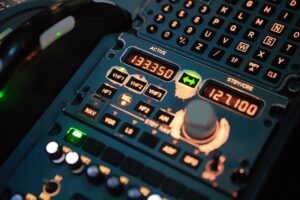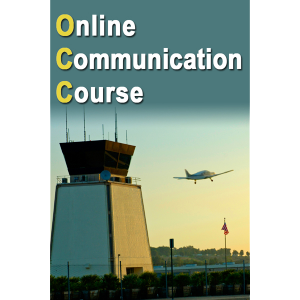 Many pilots struggle with radio communication. This task is often overlooked when people decide to become pilots, but the struggle is not just limited to students. Just like learning any other language, it may initially be challenging, but once you memorize the vocabulary and develop a keen understanding of “radio grammar,” speaking on the radios becomes second nature. Here are some tips to help all pilots communicate more effectively on the radios.
Many pilots struggle with radio communication. This task is often overlooked when people decide to become pilots, but the struggle is not just limited to students. Just like learning any other language, it may initially be challenging, but once you memorize the vocabulary and develop a keen understanding of “radio grammar,” speaking on the radios becomes second nature. Here are some tips to help all pilots communicate more effectively on the radios.
Study The Phrases
Wouldn’t it be difficult to speak to someone in a foreign language if you didn’t know a single word from that language? When it comes to aviation, it is imperative that you first learn the acceptable words and phrases before communicating on the radios.
The first thing to learn would be the phonetic alphabet. Many of us are familiar with the first three – Alpha, Bravo, and Charlie, but have you ever had to stop and think about the letters before saying them? Maybe you’ve wondered what represents “H” or “X” (hotel / x-ray)? Don’t forget about numbers. Do you know the correct pronunciation for four and five (fow-er / fife)? The phonetic alphabet and correct pronunciations are found in the Aeronautical Information Manual, Chapter 4−2−7.
Hint: If you’re new to this aviation lingo, start using the phonetic alphabet to spell out other items you see everyday, such as license plates, or road signs, or email subjects from your inbox. The more you use it, the faster you will learn it.
Once you’ve mastered the phonetic alphabet, you need to learn what to say on the radio. Delivering information on the radios can be divided into chunks, and these chunks come in a certain order. Most radio communications follow the same format, which you can remember as the “four W’s.” State:
- Whom you are calling,
- Who you are,
- Where you are,
- What your request is.
When initially contacting the tower, state, in order:
- The name of the tower,
- Your aircraft type and call sign,
- Your position, and
- Your request.
 For example, “Gainesville tower, Bonanza 6-6-4-2-1, one-zero miles west, inbound landing with alpha.”
For example, “Gainesville tower, Bonanza 6-6-4-2-1, one-zero miles west, inbound landing with alpha.”
When communicating with ATC, you are required to read back instructions to them. You’ll need to first learn which communications are required, then make sure you understand them when instructions are given to you. Don’t be surprised if the controller calls you out for not reading back specific information. We all need to ensure that instructions have been positively received and understood to prevent accidents. Some common examples that some pilots tend to omit include runway assignments, hold short requests, runway crossing clearances, and the specific runway in a landing clearance. Take time to listen to other pilots on the frequency and try to imagine where they are located based on their communications.
Practice
Once you have familiarized yourself with the words and phrases, practice how a typical conversation with ATC might sound on your own. Attempt to recite both your transmissions and ATC’s transmissions, as you will then be aware of the responses you may receive from the controller. Once you have gained more courage, ask a pilot-friend or your instructor to provide you with common ATC transmissions and respond to them in the proper manner. Role playing with your instructor or another experienced pilot will help you learn communications. It may also be beneficial to visit websites that transmit real-world ATC frequencies to study and analyze how other pilots communicate in real-time.
Be Concise
Brevity is important when on the radios. Controllers are only looking for information that is important to them. As you fly, you will begin to recognize information that is important and information that should be omitted. Doing so helps keep the frequencies clear of any unnecessary chatter and allows other pilots to jump on and speak to ATC. Efficient communication is important – nobody likes a “radio hog.”
Use Mnemonics
 While getting used to longer radio communications, mnemonics might be your best friend. The Four W’s, as described above, is an effective way to remember the important information required and the order in which they should be transmitted. Another very important mnemonic is “CRAFT,” which is used for copying clearances, especially when departing from busier airspace or when receiving a clearance from a flight plan. Upon receiving your clearance, the controller will provide your:
While getting used to longer radio communications, mnemonics might be your best friend. The Four W’s, as described above, is an effective way to remember the important information required and the order in which they should be transmitted. Another very important mnemonic is “CRAFT,” which is used for copying clearances, especially when departing from busier airspace or when receiving a clearance from a flight plan. Upon receiving your clearance, the controller will provide your:
- C learance limit
- R oute of flight
- A ltitude to climb to
- F requency you should call, and
- T ransponder code
Look for other mnemonics that may help you remember key aviation phrases, and where a mnemonic doesn’t exist, create one!
Think First, Then Speak
Remember “Aviate, Navigate, and Communicate.” This phrase is important not only in emergencies but in every phase of flight. Always fly the aircraft first. Then, gain situational awareness by determining where you are. Next, think about what the controller is saying before responding. Swift response to ATC is ideal, but if you are in doubt about what a controller is saying, ask for clarification. It is always better to communicate effectively than to hoard the frequencies with blabber – or worse, thinking you heard one thing and causing a deviation.
Getting to an acceptable pace when communicating on the radios takes time and practice. Ironically, many new pilots often get nervous on the radios and speak too fast to the point that it is incomprehensible. As mentioned above, it is good practice to respond quickly, but it is just as important to respond clearly. Do not attempt to replicate the pace at which airline pilots communicate. These pilots are well seasoned on the radios and are very familiar with being clear and providing only the most essential information to ATC. Run your own race, and learn as you go.
Practice Radio Etiquette
Flying can sometimes be highly stressful. Being responsible and practicing good radio etiquette can help reduce the stress of everyone in the vicinity of an airport. For example, if you hear someone else struggling with communications, try to not talk through their communications. If an aircraft is in distress and is considering declaring an emergency, never interrupt their communications. Additionally, when ATC requests information from an aircraft in the area and the pilot does not respond immediately, take a moment to pause before cutting in. Hopping on the frequency too soon may obstruct another pilot’s attempt to respond to ATC.
Hint: You will inevitably hear other pilots use improper phraseology from time to time. Just because someone else doesn’t properly communicate, that doesn’t mean you should match their level of unprofessionalism.
Although there are proper phrases to follow when communicating with ATC, there may be times when you may require some assistance. Whether you’re a student pilot on your first solo flights or a seasoned professional, when something seems amiss or unclear, speak up! Tell ATC if you are a student pilot or when you require assistance. You will not be ignored or neglected. Quite the contrary, ATC is an extra layer of safety to help you navigate safely. Instead of giving you a handful of instructions, the controller may break up the information, such as vector headings, and provide it to you incrementally so that you do not have too much to focus on at any given time.
 Hint: When flying into a large towered airport that you’re unfamiliar with, ask ATC for progressive taxi instructions. They will give you the step-by-step instructions to your destination. Write
Hint: When flying into a large towered airport that you’re unfamiliar with, ask ATC for progressive taxi instructions. They will give you the step-by-step instructions to your destination. Write
In conclusion, learning ATC phraseology may be challenging at first, but with every flight, you will come closer to mastering radio communications. To learn more about proper radio phraseology, refer to the Aeronautical Information Manual, Chapter 4, Section 2. You can also enroll in the Gleim Online Communications Course.
Written by Ryan Jeff, Aviation Research Assistant



